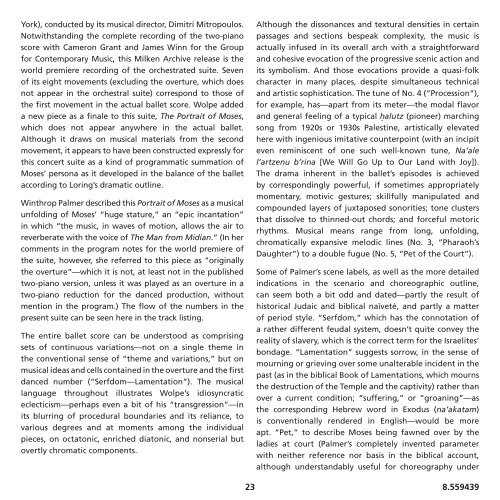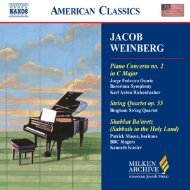Download Liner Notes PDF - Milken Archive of Jewish Music
Download Liner Notes PDF - Milken Archive of Jewish Music
Download Liner Notes PDF - Milken Archive of Jewish Music
Create successful ePaper yourself
Turn your PDF publications into a flip-book with our unique Google optimized e-Paper software.
York), conducted by its musical director, Dimitri Mitropoulos.Notwithstanding the complete recording <strong>of</strong> the two-pianoscore with Cameron Grant and James Winn for the Groupfor Contemporary <strong>Music</strong>, this <strong>Milken</strong> <strong>Archive</strong> release is theworld premiere recording <strong>of</strong> the orchestrated suite. Seven<strong>of</strong> its eight movements (excluding the overture, which doesnot appear in the orchestral suite) correspond to those <strong>of</strong>the first movement in the actual ballet score. Wolpe addeda new piece as a finale to this suite, The Portrait <strong>of</strong> Moses,which does not appear anywhere in the actual ballet.Although it draws on musical materials from the secondmovement, it appears to have been constructed expressly forthis concert suite as a kind <strong>of</strong> programmatic summation <strong>of</strong>Moses’ persona as it developed in the balance <strong>of</strong> the balletaccording to Loring’s dramatic outline.Winthrop Palmer described this Portrait <strong>of</strong> Moses as a musicalunfolding <strong>of</strong> Moses’ “huge stature,” an “epic incantation”in which “the music, in waves <strong>of</strong> motion, allows the air toreverberate with the voice <strong>of</strong> The Man from Midian.” (In hercomments in the program notes for the world premiere <strong>of</strong>the suite, however, she referred to this piece as “originallythe overture”—which it is not, at least not in the publishedtwo-piano version, unless it was played as an overture in atwo-piano reduction for the danced production, withoutmention in the program.) The flow <strong>of</strong> the numbers in thepresent suite can be seen here in the track listing.The entire ballet score can be understood as comprisingsets <strong>of</strong> continuous variations—not on a single theme inthe conventional sense <strong>of</strong> “theme and variations,” but onmusical ideas and cells contained in the overture and the firstdanced number (“Serfdom—Lamentation”). The musicallanguage throughout illustrates Wolpe’s idiosyncraticeclecticism—perhaps even a bit <strong>of</strong> his “transgression”—inits blurring <strong>of</strong> procedural boundaries and its reliance, tovarious degrees and at moments among the individualpieces, on octatonic, enriched diatonic, and nonserial butovertly chromatic components.Although the dissonances and textural densities in certainpassages and sections bespeak complexity, the music isactually infused in its overall arch with a straightforwardand cohesive evocation <strong>of</strong> the progressive scenic action andits symbolism. And those evocations provide a quasi-folkcharacter in many places, despite simultaneous technicaland artistic sophistication. The tune <strong>of</strong> No. 4 (“Procession”),for example, has—apart from its meter—the modal flavorand general feeling <strong>of</strong> a typical ḥalutz (pioneer) marchingsong from 1920s or 1930s Palestine, artistically elevatedhere with ingenious imitative counterpoint (with an incipiteven reminiscent <strong>of</strong> one such well-known tune, Na’alel’artzenu b’rina [We Will Go Up to Our Land with Joy]).The drama inherent in the ballet’s episodes is achievedby correspondingly powerful, if sometimes appropriatelymomentary, motivic gestures; skillfully manipulated andcompounded layers <strong>of</strong> juxtaposed sonorities; tone clustersthat dissolve to thinned-out chords; and forceful motoricrhythms. <strong>Music</strong>al means range from long, unfolding,chromatically expansive melodic lines (No. 3, “Pharaoh’sDaughter”) to a double fugue (No. 5, “Pet <strong>of</strong> the Court”).Some <strong>of</strong> Palmer’s scene labels, as well as the more detailedindications in the scenario and choreographic outline,can seem both a bit odd and dated—partly the result <strong>of</strong>historical Judaic and biblical naïveté, and partly a matter<strong>of</strong> period style. “Serfdom,” which has the connotation <strong>of</strong>a rather different feudal system, doesn’t quite convey thereality <strong>of</strong> slavery, which is the correct term for the Israelites’bondage. “Lamentation” suggests sorrow, in the sense <strong>of</strong>mourning or grieving over some unalterable incident in thepast (as in the biblical Book <strong>of</strong> Lamentations, which mournsthe destruction <strong>of</strong> the Temple and the captivity) rather thanover a current condition; “suffering,” or “groaning”—asthe corresponding Hebrew word in Exodus (na’akatam)is conventionally rendered in English—would be moreapt. “Pet,” to describe Moses being fawned over by theladies at court (Palmer’s completely invented parameterwith neither reference nor basis in the biblical account,although understandably useful for choreography under23 8.559439
















